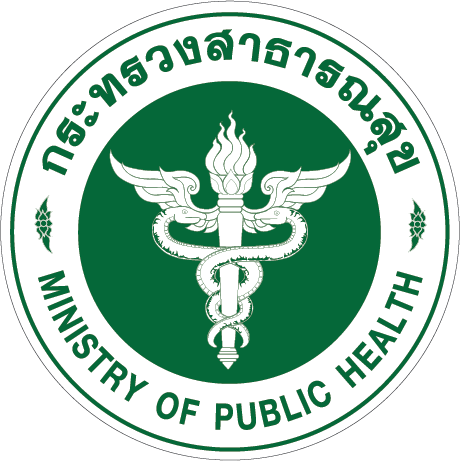การประเมินผลกระทบด้านงบประมาณจากการใช้ยาในกลุ่ม PCSK9 Inhibitors ในผู้ป่วยโรคหัวใจและหลอดเลือด ในสถาบันโรคทรวงอก
คำสำคัญ:
ยากลุ่ม PCSK9 inhibitors, โรคหัวใจและหลอดเลือดจากหลอดเลือดแดงแข็งบทคัดย่อ
ความเป็นมา: Proprotein convertase subtilisin kexin type 9 (PCSK9) inhibitors เป็นทางเลือกใหม่ในการรักษาด้วยยาเพื่อลดระดับ low density lipoprotein cholesterol (LDL-C) ในเลือด ที่มีประโยชน์ในการลดการเกิดโรคหัวใจและหลอดเลือด แต่ปัจจุบันยังเป็นยาใหม่ที่มีราคาสูงมาก
วัตถุประสงค์: เพื่อประเมินผลกระทบด้านงบประมาณจากการใช้ยาในกลุ่ม PCSK9 inhibitors คือ evolocumab ในผู้ป่วยโรคหัวใจและหลอดเลือดที่เกิดจากหลอดเลือดแดงแข็ง (altherosclerotic cardiovascular disease; ASCVD)
วิธีการวิจัย: เก็บข้อมูลย้อนหลังโดยการทบทวนเวชระเบียนผู้ป่วย ASCVD ที่เข้ารับการรักษาในสถาบันโรคทรวงอก ตั้งแต่วันที่ 1 ตุลาคม พ.ศ. 2562 ถึง 30 กันยายน พ.ศ.2563 ติดตามผู้ป่วยเป็นระยะเวลา 1 ปี จากนั้นแบ่งผู้ป่วยตามผลตอบสนองต่อยาลดไขมันในเลือด เป็น 3 กลุ่ม ได้แก่ กลุ่มที่ 1) ผู้ป่วยทุกรายที่มีระดับ LDL-C ≥ 70 มก./ดล. กลุ่มที่ 2) ผู้ป่วยที่ได้รับยา high intensity statin แล้วยังมีค่า LDL-C ≥ 70 มก./ดล. และกลุ่มที่ 3) ผู้ป่วยที่ได้รับยา high intensity statin ร่วมกับยา ezetimibe แล้วยังมีค่า LDL-C ≥ 70 มก./ดล. สร้างสถานการณ์สมมุติในการเพิ่มยา evolocumab ร่วมในการรักษาแต่ละกลุ่ม ประเมินและเปรียบเทียบค่าใช้จ่ายที่เพิ่มขึ้นจากยา evolocumab ในแต่ละสถานการณ์ ตามราคายาปัจจุบันในประเทศไทย
ผลการวิจัย: ผู้ป่วย ASCVD ที่มีข้อบ่งชี้ในการใช้ยาในกลุ่ม PCSK9 inhibitors จำนวน 7,491 ราย มีค่ามัธยฐานของระดับ LDL-C ก่อนเริ่มให้ยาลดไขมันในเลือดเท่ากับ 120.43 มก./ดล. เมื่อติดตามผู้ป่วยเป็นระยะเวลา 1 ปี พบว่าผู้ป่วยร้อยละ 77.79 ยังมีระดับระดับ LDL-C มากกว่า 70 มก./ดล. และหากเพิ่มการรักษาด้วยยา evolocumab ในผู้ป่วย ASCVD ในแต่ละกลุ่มจะต้องใช้งบประมาณด้านยาเพิ่มขึ้น ดังนี้ กลุ่มที่1) 1,567 – 2,164 ล้านบาท/ปี กลุ่มที่ 2) 885 – 1,222 ล้านบาท/ปี และกลุ่มที่ 3) 147 – 203 ล้านบาท/ปี
สรุปผล: การเพิ่มยา evolocumab ร่วมในการรักษาผู้ป่วย ASCVD เพื่อลดระดับ LDL-C ให้ <70 มก./ดล. ตามแนวทางปฏิบัติมาตรฐาน คาดการณ์ว่าจะทำให้งบประมาณค่าใช้จ่ายด้านยาเพิ่มขึ้น 147-2,164 ล้าบาท/ปี โดยหากเลือกใช้ยาเฉพาะในกรณีที่ผู้ป่วยได้รับยา high intensity statin ร่วมกับ ezetimibe แล้วยังมีค่า LDL-C ≥ 70 มก./ดล. อาจจะลดค่าใช้จ่ายด้านยาลงได้ถึง 1,420 – 1,961 ล้านบาท/ปี เมื่อเทียบกับการใช้ยาในผู้ป่วยทุกรายที่มีระดับ LDL-C ≥ 70 มก./ดล.
เอกสารอ้างอิง
Stone NJ, Robinson JG, Lichtenstein AH, Bairey Merz CN, Blum CB, Eckel RH, et al. 2013 ACC/AHA guideline on the treatment of blood cholesterol to reduce atherosclerotic cardiovascular risk in adults: a report of the American College of Cardiology/American Heart Association Task Force on Practice Guidelines. J Am Coll Cardiol. 2014;63(25 Part B):2889-934. doi: 10.1016/j.jacc.2013.11.002.
Lloyd-Jones DM, Morris PB, Ballantyne CM, Birtcher KK, Daly DD Jr, DePalma SM, et al. 2016 ACC expert consensus decision pathway on the role of non-statin therapies for LDL-cholesterol lowering in the management of atherosclerotic cardiovascular disease risk: a report of the American College of Cardiology Task Force on Clinical Expert Consensus Documents. J Am Coll Cardiol. 2016; 68(1):92-125. doi: 10.1016/j.jacc.2016.03.519.
Taylor F, Ward K, Moore TH, Burke M, Davey Smith G, Casas JP, et al. Statins for the primary prevention of cardiovascular disease. Cochrane Database Syst Rev. 2011;(1):CD004816. doi: 10.1002/14651858.CD004816.pub4.
Cholesterol Treatment Trialists' (CTT) Collaboration; Fulcher J, O'Connell R, Voysey M, Emberson J, Blackwell L, Mihaylova B, et al. Efficacy and safety of LDL-lowering therapy among men and women: meta-analysis of individual data from 174,000 participants in 27 randomised trials. Lancet. 2015;385(9976):1397-405. doi: 10.1016/S0140-6736(14)61368-4.
Cannon CP, Blazing MA, Giugliano RP, McCagg A, White JA, Theroux P, et al. Ezetimibe added to statin therapy after acute coronary syndromes. N Engl J Med. 2015;372(25):2387-97. doi: 10.1056/NEJMoa1410489.
Sabatine MS, Giugliano RP, Keech AC, Honarpour N, Wiviott SD, Murphy SA, et al. Evolocumab and clinical outcomes in patients with cardiovascular disease. N Engl J Med. 2017;376(18):1713-22. doi: 10.1056/NEJMoa1615664.
Sabatine MS, Giugliano RP, Wiviott SD, Raal FJ, Blom DJ, Robinson J, et al. Efficacy and safety of evolocumab in reducing lipids and cardiovascular events. N Engl J Med. 2015; 372(16):1500-9. doi: 10.1056/NEJMoa1500858.
Amgen Inc. REPATHA® (evolocumab) injection, for subcutaneous use. In: Drugs@FDA: FDA-Approved Drugs [Internet]. n.p.: U.S. Food and Drug Administration; 2017 [cited 2018 May 22]. Available from: https://www.accessdata.fda.gov/drugsatfda_docs/label/2021/125522orig2s000lbl.pdf
Amgen Inc. REPATHA® solution for injection: summary of product characteristics. In: European Medicines Agency [Internet]. Amsterdam: European Medicines Agency; 2017 [cited 2018 May 22]. Available from: https://www.ema.europa.eu/en/documents/product-information/repatha-epar-product-information_en.pdf
Kazi DS, Moran AE, Coxson PG, Penko J, Ollendorf DA, Pearson SD, et al. Cost-effectiveness of PCSK9 inhibitor therapy in patients with heterozygous familial hypercholesterolemia or atherosclerotic cardiovascular disease. JAMA. 2016;316(7):743-53. doi: 10.1001/jama.2016.11004.

ดาวน์โหลด
เผยแพร่แล้ว
วิธีการอ้างอิง
ฉบับ
บท
การอนุญาต
ลิขสิทธิ์ (c) 2023 กองบริหารการสาธารณสุข สำนักงานปลัดกระทรวงสาธารณสุข และ ชมรมเภสัชกรโรงพยาบาลกระทรวงสาธารณสุข

This work is licensed under a Creative Commons Attribution-NonCommercial-NoDerivatives 4.0 International License.
ข้อความภายในบทความที่ตีพิมพ์ในวารสารเภสัชกรรมคลินิกทั้งหมด รวมถึงรูปภาพประกอบ ตาราง เป็นลิขสิทธิ์ของกองบริหารการสาธารณสุข สำนักงานปลัดกระทรวงสาธารณสุข และ ชมรมเภสัชกรโรงพยาบาลกระทรวงสาธารณสุข การนำเนื้อหา ข้อความหรือข้อคิดเห็น รูปภาพ ตาราง ของบทความไปจัดพิมพ์เผยแพร่ในรูปแบบต่าง ๆ เพื่อใช้ประโยชน์ในเชิงพาณิชย์ ต้องได้รับอนุญาตจากกองบรรณาธิการวารสารเภสัชกรรมคลินิกอย่างเป็นลายลักษณ์อักษร
กองบริหารการสาธารณสุข สำนักงานปลัดกระทรวงสาธารณสุข และ ชมรมเภสัชกรโรงพยาบาลกระทรวงสาธารณสุข อนุญาตให้สามารถนำไฟล์บทความไปใช้ประโยชน์และเผยแพร่ต่อได้ โดยอยู่ภายใต้เงื่อนไขสัญญาอนุญาตครีเอทีฟคอมมอน (Creative Commons License: CC) โดย ต้องแสดงที่มาจากวารสาร – ไม่ใช้เพื่อการค้า – ห้ามแก้ไขดัดแปลง, Attribution-NonCommercial-NoDerivatives 4.0 International (CC BY-NC-ND 4.0)
ข้อความที่ปรากฏในบทความในวารสารเป็นความคิดเห็นส่วนตัวของผู้เขียนแต่ละท่านไม่เกี่ยวข้องกับกองบริหารการสาธารณสุข สำนักงานปลัดกระทรวงสาธารณสุข และ ชมรมเภสัชกรโรงพยาบาลกระทรวงสาธารณสุข และบุคลากรในกองฯ หรือ ชมรมฯ แต่อย่างใด ความรับผิดชอบองค์ประกอบทั้งหมดของบทความแต่ละเรื่องเป็นของผู้เขียนแต่ละท่าน หากมีความผิดพลาดใด ๆ ผู้เขียนแต่ละท่านจะรับผิดชอบบทความของตนเอง ตลอดจนความรับผิดชอบด้านเนื้อหาและการตรวจร่างบทความเป็นของผู้เขียน ไม่เกี่ยวข้องกับกองบรรณาธิการ



